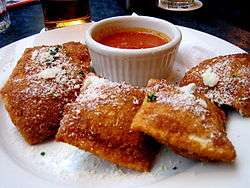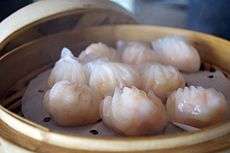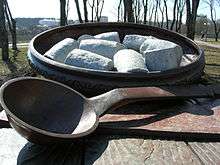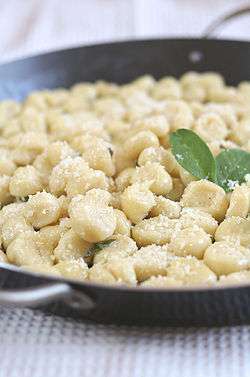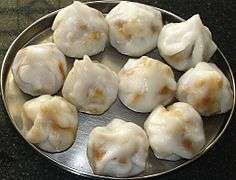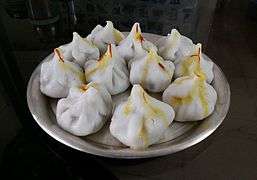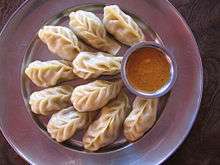Dumpling
Dumpling is a broad classification for a dish that consists of pieces of dough (made from a variety of starch sources) wrapped around a filling, or of dough with no filling. The dough can be based on bread, flour or potatoes, and may be filled with meat, fish, cheese, vegetables, fruits or sweets. Dumplings may be prepared using a variety of methods, including baking, boiling, frying, simmering or steaming and are found in many world cuisines.
A fried dumpling filled with minced chicken and spring onion, originally from China | |
| Main ingredients | Flour, potatoes or bread |
|---|---|
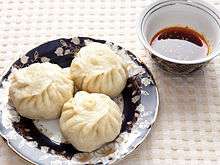
African
Banku and kenkey are defined as dumplings in that they are starchy balls of dough that are steamed. They are formed from fermented cornmeal. Banku is boiled and requires continuous kneading, while kenkey is partly boiled then finished by steaming in corn or banana leaves.[1]
Tihlo—prepared from roasted barley flour—originated in the Tigray region of Ethiopia and is now very popular in Amhara as well and spreading further south.[2]
Souskluitjies are dumplings found in South Africa. They are a steamed sweet dumpling, sometimes made with plain flour and sometimes with the addition of dried fruits or other flavors. They are often served with a syrup flavored with cinnamon or a custard sauce.[3][4]
South Africa has another kind of dumpling known as melkkos. These dumplings are formed by putting milk, one teaspoon at a time, into a dry flour mixture. The flour clings to the milk and forms dumplings, which are then boiled in a mixture of milk and butter. They are served hot and sprinkled with cinnamon sugar.[5]
South Africa also has a kind of dumpling-dough called dombolo, ujeqe or steam bread, which is very popular and common in South African cuisine.
North America
American dumplings may be of the filled pastry type (which are usually baked), or they may be little pieces of dough added to a savoury or sweet dish, in which case they are usually boiled.
Baked sweet dumplings are a popular dessert in American cuisine. They are made by wrapping fruit, frequently a whole tart apple, in pastry, then baking until the pastry is browned and the filling is tender. While baking, the dumplings may be surrounded by, and even basted in, a sweet sauce, typically containing brown sugar, butter, and cinnamon or other spices.
Baked savory dumplings, in the form of pizza rolls, are a popular prepared snack food.
Boiled dumplings are made by mixing flour, fat, and baking powder with milk or water to form a dough, which may be either rolled out and cut into bite-size pieces, or simply dropped by spoonfuls into the simmering liquid of a savoury soup or stew, or, for dessert dumplings, onto simmering sweetened fruit. The dropped kind are sometimes called "doughboys," When added to chicken and vegetables in chicken broth, the starch in the dumplings serves to thicken the broth into a gravy, creating the popular comfort food chicken and dumplings. Other common savoury pairings, particularly in the Midwestern and Southern US, are turkey, ham, and butter-beans. Popular sweet pairings are strawberries, apples, and blackberries. Dumplings also feature in the regional stews of the midwest and south called "burgoos." Further north, dumplings are frequently served with beef, corned-beef and duck stews, and blueberries are the favourite fruit for dessert dumplings.
In Canada, the Poutine râpée is a type of filled dumpling made with pork mince inside a flour ball.
Central Asian
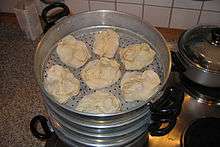
Manti (also manty or mantu) is a steamed dumpling in Central Asian and Chinese Islamic cuisine. It contains a mixture of ground lamb (or beef) spiced with black pepper, enclosed in a dough wrapper. Manti are cooked in a multi-level steamer (mantovarka) and served topped with butter, yogurt, sour cream, or onion sauce. These dumplings are popular throughout Central Asia, including in Afghanistan, Kazakhstan, Kyrgyzstan, Pakistan, Tajikistan, Uzbekistan,the Xinjiang region in China and the Caucasus.
Chuchvara is a very small boiled dumpling typical of Uzbek and Tajik cuisine. Made of unleavened dough squares filled with meat, it is similar to the Russian pelmeni and the Chinese wonton, but in observance of the Islamic dietary rules, the meat filling is without pork. Chuchvara can be served in a clear soup or on their own, with vinegar or sauce based on finely chopped greens, tomatoes and hot peppers. Another popular way of serving chuchvara is topped with suzma (strained qatiq) or with smetana (sour cream), Russian-style.
East Asian
Chinese
A legend goes that dumplings were first invented in the era of the Three Kingdoms, around 225 AD. Zhuge Liang, a general and minister of Shu Han, dammed up a poison marsh on his southern campaign against the Nanman with dumplings instead of the heads that the Nanman used. However, this legend is more commonly associated with the mantou (the name is supposedly evolved from "馒头", also pronounced as "mantou").
The jiǎozi (![]()
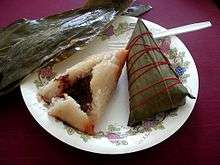
If dumplings are laid flatly on a pan, first steamed with a lid on and with a thin layer of water, then fried in oil after the water has been evaporated, they are called guotie (鍋貼, literally translates to "potstickers"). The same dumplings are called jiaozi if they are just steamed or boiled.
The wonton (Cantonese name) or hún dun in Mandarin (雲呑/餛飩) is another kind of dumpling. The shape is similar to Italian tortellino. It is typically boiled in a light broth or soup and made with a meat or shrimp filling. The skin wrapping for wontons is different—thinner and less elastic—than that used for jiaozi . Wontons are more popular in Southern China (Shanghai, Guangdong, Hong Kong etc.), whereas in Northern China, jiaozi are more popular. Jiaozi, wonton and potstickers are each wrapped differently.
Another type of Chinese dumpling is made with glutinous rice. Usually, the glutinous rice dumplings, zongzi (粽子), are triangle or cone shaped, can be filled with red bean paste, Chinese dates or cured meat depending on region. Glutinous rice dumplings are traditionally eaten during the Duanwu Festival. Other types of dumplings would be "soup dumplings", commonly referred to as xiaolongbao (小籠包).
Chinese cuisine also include sweet dumplings. Tangyuan (湯圓) are smaller dumplings made with glutinous rice flour and filled with sweet sesame, peanut, red bean paste. Tangyuan may also be served without a filling. Tangyuan are eaten on the 15th day of Chinese New Year, or the Lantern Festival. In Southern China, people will also eat the sweet dumplings (tangyuan) with shape angle on the top, in the Winter Solstice meaning the harvest in the coming year.[8]
See also: dim sum (點心) for descriptions of several other kinds of dumplings such as har gow, fun guo, siew mai, Cha siu bao, lo mai gai and crystal dumplings.
Japanese
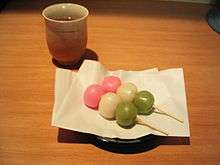
- Dango (団子) is a sweet dumpling made from rice flour, similar to mochi. Dango is eaten year-round, but the different varieties are traditionally eaten in given seasons. Three to four dango are often served on a skewer.
- Gyōza (ギョーザ/餃子) is the Japanese version of the Chinese jiaozi.
- Nikuman (肉まん) is the Japanese variant of baozi.
Korean
Korean dumplings are called mandu (만두, 蠻頭). They are typically filled with a mixture of ingredients, including ground pork, kimchi, vegetables, cellophane noodles, but there are very many variations. Mandu can be steamed, fried, or boiled. The dumplings can also be used to make a soup called mandu-guk (만둣국).
Mongolian
- Buuz (Бууз) Mongolian dumplings are called (Бууз). They are generally made of dough, minced garlic and ground beef or ground mutton. It is one of the main festival food during the Mongolian Lunar New Year.
- Khuushuur (хуушууp) It is representative food during one of the National's main festival, Naadam.
- Bansh are smaller version of Buuz. Bansh can be steamed, fried, or boiled in a milk tea or a soup.
Caribbean and Latin America
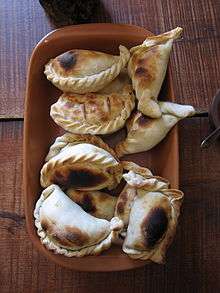
Empanadas, whose stuffing, manufacture and types are numerous and varied, differ from traditional dumplings in that they are deep fried or steamed, and excess dough is not cut off.
Bajan
In Barbados, dumplings differ from those in other Caribbean islands in that they are slightly sweetened. The dumplings may either be of the flour or cornmeal variety. The dough is flavoured with spices, cinnamon and nutmeg. Dumplings are often added with Bajan soup where they are boiled. When found in Stew food, the dumplings are steamed along with ground provision, salted meat, plantain and other ingredients which is served with gravy.
Brazilian
In Brazil, there are :
- Pastéis, thin dough that is mainly stuffed with cheese and then fried,
- Empada, muffin-shaped dough stuffed primarily with chicken, cheese or seafood (this is NOT Empanadas).
- Coxinhas, thick dough stuff with chicken (could be described as a chicken corn dog ), and
- bolinhas, which literally translates to 'little balls', can have meat(bolinhas de carne) or cheese(bolinhas de queijo) inside.
All dumplings can vary of its original form with optional additions like olives, onions or spices. They are commonly served in parties. In some parts of Brazil like Rio it can be found in fast-food kiosks('open restaurants', where there is no door to enter and you are served in a big counter) in the city or in parks, but it is very diffused through the territory, so you could find people who also eat these on the beach or after work with beer, fruity alcoholic drinks known as batidas, or non-alcoholic beverages like soda or refrescos(sort of juice).
Caribbean
Dumplings are either pan fried using a simple recipe including all-purpose flour, water, and salt made into a thick dough before frying on a pan until golden brown, or boiled in a soup. The fried version is usually served with breakfast codfish as a side.
Chilean
In Chile, there are pantrucas, a type of flat, elongated irregular dumplings flavoured with fresh parsley and served in soup. In Chiloé, a Chilean southern archipelago, one of the American regions potato is native from, traditional meal are "chapalele", "milcao", "chochoca", "chuhuañe" and "vaeme". All of them made potato based, cooked or raw and sometimes mixed in different proportions of wheat flour, seasoned with lard. Some are flat and round filled with greaves and fried (milcao); flat boiled (chapaleles, milcaos), similar but bigger to "pantrucas or pancutras" or a roasted roll in a stick (chochoca). Size is one portion and regularly served as bread. Also are served with honey (mainly hot chapaleles, as dessert). In Chile also existing traditional "papas rellenas". Boiled potatoes and flour dough; meat,onion,some cumin filled and fried; served regularly with crystallized sugar over.
Jamaican
Dumplings come in three forms in Jamaica, fried, boiled, and roasted. All are made with flour, white or wheat, and the white-floured dumplings are often mixed with a bit of cornmeal. These foods are often served with a variety of dishes like ackee and saltfish, kidneys, liver salt mackerel, etc. and often taste better when refried. A refried dumpling is an already boiled dumpling left over from previous cooking that is fried, which gives it a slightly crispy outer layer and a tender middle. A purely fried white flour dumpling (also known as a "Johnny Cake") is golden brown and looks similar to a buñuelo, often substituting the boiled dumpling, but it is mostly consumed as part of breakfast. Fried dumplings can be made with or without sugar. One popular variation is the Jamaican Festival a cylindrical fried dumpling made with flour, sugar, cornmeal and baking powder. These slightly sweet dumplings are served with all types of traditional Jamaican home food, particularly as a complement to the sweet-and-sour escovitched fish, as well as street food.
Peruvian
"Papas Rellenas" or stuffed potatoes consist of a handful of mashed potatoes (without the milk and butter) flattened in the palm of the hand and stuffed with a savoury combination of ingredients. The stuffing usually consists of sautéed meat (could be beef, pork or chicken), onions and garlic. They are all seasoned with cumin, aji, raisins, peanuts, olives and sliced or chopped hard boiled eggs. After stuffing a ball is formed, rolled over flour and deep fried in hot oil. The stuffed potatoes are usually accompanied by onion sauce consisting of sliced onions, lime juice, olive oil, salt, pepper and slices of fresh peppers. The same dish may also be made with seafood. In some countries, yuca purée is used as the starch component of these Latin American dumplings.
Puerto Rican
In Puerto Rico, dumplings are made of grated tubers such as yuca and malanga with added calabaza, unripe bananas and plantains mixed with flour. These dumplings are a traditional part of Puerto Rican-style pigeon pea soup. Olive oil and annatto are usually added and help the mix from turning brown. The dumplings are formed into small balls and are first cooked in olive oil before boiling. Once the dumplings are crispy on the outside, they are then boiled with added ingredients.
The pastel, a dumpling made from a masa of grated root vegetables, squash, plantains, and unripe bananas, is greatly beloved here, especially around Christmas. The Puerto Rican variety has a tender, slightly wet consistency. The masa dough is mixed with milk and annatto mixed in oil or lard, then stuffed with stewed pork, chick peas, olives, capers and/or even raisins. The dumplings are then wrapped in a fragrant banana leaf, tied and then boiled or steamed. The origin of pasteles leads back to Natives on the island of Borikén. Pasteles are popular in the Dominican Republic, Hawaii, Trinidad and lately seen in Cuban cuisine.
Venezuela
In the city of El Callao, domplines are fried and made from wheat. Usually filled with curry chicken and cheese.[10] There usually present in the carnivals of Calypso de El Callao.
European
British and Irish
Savoury dumplings made from balls of dough are part of traditional British and Irish cuisine. Traditionally dumplings are made from twice the weight of self raising flour to suet, bound together by cold water to form a dough and seasoned with salt and pepper but can also be made using flour and butter. Balls of this dough are dropped into a bubbling pot of stew or soup, or into a casserole. They sit, partly submerged in the stew, and expand as they are half-boiled half-steamed for ten minutes or so. The cooked dumplings may be airy on the inside and moist on the outside. The dough may be flavoured with herbs, or it may have cheese pressed into its centre.
The Norfolk dumpling is not made with fat, but from flour and a raising agent.[11] Cotswold dumplings call for the addition of breadcrumbs and cheese, and the balls of dough may be rolled in breadcrumbs and fried, rather than cooked in a soup or stew.[12] Vegetarian dumplings can be made with vegetable suet, a type of shredded vegetable fat. When sweetened with dried fruit and spices, dumplings can be boiled in water to make a dessert. In Scotland, this is called a clootie dumpling, after the cloth.[13]
France
Raviole du Dauphiné (in English, 'Dauphiné ravioli') are the best-known French dumpling. The regional speciality consisting of two layers of pasta made out of tender wheat flour, eggs and water, surrounding a filling of Comté or Emmental cheese, cottage cheese made of cow's milk, butter and parsley. They are usually associated with the historic region of Dauphiné in South-Central France.
Central European
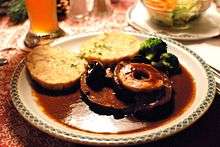
Germany, Romania, Austria, the Czech Republic and Slovakia boast a large variety of dumplings, both sweet and savoury. A dumpling is called Kloß in Northern Germany, Knödel, Nockerl or Knöpfle in Southern Germany and Austria. These are flour dumplings, the most common dumplings, thin or thick, made with eggs and semolina flour, boiled in water. Meat dumplings (called Klopse or Klöpse in North-Eastern Germany, Knöpfle and Nocken in Southern Germany) contain meat or liver. Liver dumplings are frequent additions to soup. Thüringer Klöße are made from raw or boiled potatoes, or a mixture of both, and are often filled with croutons. Bread dumplings are made with white bread and are sometimes shaped like a loaf of bread, and boiled in a napkin, in which case they are known as napkin dumplings (Serviettenknödel).
Maultaschen are a Swabian (Baden-Württemberg) specialty food, consisting of an outer layer of pasta dough with a filling traditionally made of sausage meat, spinach, bread crumbs and onions and flavored with various spices. Similar in appearance to Italian ravioli, Maultaschen are usually larger, however, each Maultasche being about 8–12 cm (3-5 inches) across.
The only potato dumpling museum in the world, the Thüringer Kloßmuseum, is located in Germany, in the municipality of Heichelheim near Weimar.
Halušky are a traditional variety of dumplings cooked in the Central and Eastern European cuisines (Czech Republic, Hungary, Poland, Romania, Serbia, Slovakia, and Ukraine). These are small lumps cut from a thick flour and egg batter and dropped into boiling water, similar to the German Spätzle, Knöpfle, or Knödel.
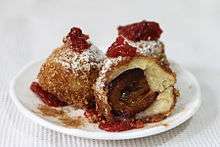
In Romania, the dumplings usually contain plums or cottage cheese and are called galusca cu prune, or coltunasi cu branza, depending on the filling. Sweet dumplings are either pre powdered, or get dragged through a plate with sugar when a sweeter taste is needed. In Hungary, dumplings are called nokedli and in Austria "Zwetschgenknödel". Sweet varieties called gombóc are made with flour and potato dough, which is wrapped around whole plums or apricots, and then boiled and rolled in hot buttered bread crumbs. Shlishkes or "Krumplinudli" are small boiled potato dumplings made from the same potato dough as the sweet plum dumplings, also rolled in hot buttered bread crumbs.
Bryndzové halušky, considered the Slovak national dish, are small potato dumplings without a filling, served with salty sheep's cheese on top. The same dumplings are also used to create a similar dish, strapačky. Also available are their related stuffed version called pirohy, usually filled with bryndza (bryndzové pirohy), quark cheese, potatoes, onions, cabbage, mushrooms, or meat.
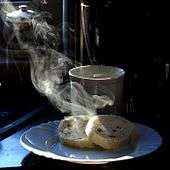
In Czech cuisine dumplings have two main forms:
- Knödel is called in Czech knedlík and in Slovakia knedľa. It can be either houskový (bread) or bramborový (potato) knödel. These dumplings are boiled in loaf shape and then cut in slices and are part of many Czech national dishes such as Vepřo knedlo zelo or Svíčková na smetaně.
- Ovocné knedlíky (ball-shaped knedle) filled in with fruit: plums, strawberry, blueberry etc. Meal is completed on plate with grated quark, melted butter and powder sugar.
Idrijski žlikrofi are Slovenian dumplings, regionally located in the town of Idrija. They are made from dough with potato filling and have a characteristic form of a hat. Žlikrofi are made by a traditional recipe from the 19th century, but the source of the recipe is unknown due to lack of historical sources. The dish may be served as a starter or a side dish to meat based dishes. Žlikrofi were the first Slovenian food to be classified as a Traditional speciality guaranteed dish.
Eastern European
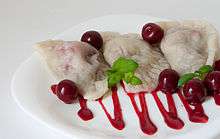
Pierogi of Poland and varenyky of Ukraine are ravioli-like crescent-shaped dumplings filled with savoury or sweet filling. Varenyky are usually boiled or steamed. Pierogi are often fried after boiling.
"Little ears", variously called uszka in Poland, ushki (ушки) in Russia, vushka (вушка) in Ukraine, and vushki (вушкі) in Belarus, are folded ring-shaped dumplings similar in shape to Italian tortellini or Jewish kreplach. They are stuffed with meat or mushrooms and traditionally served in borshch or clear soup. In Romania, "little ears" (Romanian: urechiuşe) are also served in dumpling soup (supă de găluşte)
Kluski are a different variety of Polish dumplings.
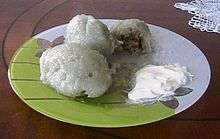
Lithuanian dough dumplings are called koldūnai and virtiniai. Usually they are filled with meat or curd. One of the varieties is called šaltanosiai, "cold nosed ones", and is made with blueberry filling. There are also potato dumplings called cepelinai or didžkukuliai, filled with meat or curd inside, served with soured cream. A similar dish exists in Belarus that is called klyocki (клёцкі).
Russian pelmeni are smaller than varenyky and made only of minced meat with addition of onions and spices. Sometimes the meat used is only beef, in other recipes is a mixture of beef with pork or mutton. Pelmeni should be juicy inside. They are unrelated to the pasta with which they are sometimes compared as it is a savoury main dish. They are usually boiled in water with spices and salt, or in meat bouillon, sometimes fried before serving. They are often served with plenty of sour cream.
.jpg)
An important difference between pelmeni, varenyky, and pierogi is the thickness of the dough shell—in pelmeni this is as thin as possible, and the proportion of filling to dough is usually higher.[14] Pelmeni are never served with a sweet filling, which distinguishes them from varenyky and pierogi, which sometimes are. Also, the fillings in pelmeni are usually raw, while the fillings of vareniki and pierogi are typically precooked.
The word pelmeni is derived from pel'n'an' (пельнянь) – literally "ear bread" in the native Finno-Ugric Komi, Udmurt, and Mansi languages.[15][16] It is unclear when pelmeni entered the cuisines of the indigenous Siberian people and when they first appeared in Russian cuisine. One theory suggests pelmeni, or stuffed boiled dumplings in general, originated in Siberia, possibly a simplified adaptation of the Chinese Wonton (in some dialect is called Bāomiàn "包面"). Pelmeni are particularly good means of quickly preserving meat during long Siberian winter, especially eliminating the need to feed livestock during the long winter months.
The main difference between pelmeni and momos is their size—a typical pelmeni is about 2 to 3 centimetres (0.79 to 1.18 in) in diameter, whereas momos are often at least twice that size.
In Siberia, especially popular with the Buryat peoples are steamed dumplings called pozi (buuz in Mongolian, from Chinese: 包子; pinyin: bāozi). They are usually made with an unleavened dough, but are often encountered leavened. The traditional filling is meat, but the kind of meat and how it is processed varies. In Mongolia, mutton is favored, and is chopped rather than ground; pork and beef mixes are more popular in Russia.
Manti, samsa, chiburekki, and belyashi are all popular imported dumplings.
Khinkali (Georgian: ხინკალი) are Georgian dumplings[17] which originated in the mountain regions of Pshavi, Mtiuleti, and Khevsureti.[18] Varieties of khinkali spread from there across different parts of the Caucasus,[19] now the towns of Dusheti, Pasanauri and Mtskheta are particularly famous for their khinkali. The fillings of khinkali vary with the area. The original recipe consists of only minced meat (lamb or beef and pork mixed), onions, chili pepper, salt and cumin. Modern recipes use herbs like parsley and coriander. In Muslim-majority areas the use of beef and lamb is more prevalent. Mushrooms, potatoes, or cheese may be used in place of meat. The khinkali is typically consumed first by sucking the juices while taking the first bite, in order to prevent the dumpling from bursting.
Italian
Ravioli and tortellini fit the basic definition of a dumpling: these are pockets of pasta enclosing various fillings (cheese, mushrooms, spinach, seafood, or meat). Instead of being made from a ball of dough, the dough is rolled flat, cut into a shape, filled with other ingredients, and then the dough is closed around the filling.
Gnocchi is a different kind of Italian dumpling. The word gnocchi literally means "lumps", and they are rolled and shaped from a mixture of egg with potato, semolina, flour, or ricotta cheese (with or without spinach). The lumps are boiled in water and served with melted butter, grated cheese, or other pasta sauces.
Maltese
Maltese ravioli (ravjul) are pockets of pasta filled with ricotta cheese.
Pastizzi and qassatat are pockets of dough that can be filled with a variety of fillings, usually ricotta (irkotta) or mashed peas.
Scandinavian
Norwegian
In Norwegian cuisine, dumplings have a vast variety of names, as the dialects differ substantially. Names include potetball, klubb, kløbb, raspeball, komle, kumle, kompe, kumpe, kodla, kudle, klot, kams, ball, baill, komperdøse, kumperdøse, kompadøs, ruter, ruta, raskekako, risk, klotremat, krumme and kromme. They are usually made from crushed potatoes mixed with various types of flour, often with an emphasis on barley and wheat. In some local recipes the potatoes are dehydrated, while in others there is a mixture of raw and boiled potatoes. Occasionally they are filled with bacon. Depending on local tradition, dumplings can be sided with syrup, swede and often meat if the dumplings does not have meat filling.
Swedish
In Swedish cuisine, potato dumplings of originally German origin[20] have several regional names, mainly depending on the type of flour used. When the potato is mixed with wheat flour, which is more common in southern Sweden, it is called kroppkaka. In Blekinge[21] and parts of the island of Öland, it is traditionally made from grated raw potato, which makes it greyish in colour, while on Gotland and in Småland it is predominantly made from mashed boiled potato, and is thus whiter in colour.[20] The kroppkaka is usually filled with diced, smoked bacon and chopped, raw onion, and is often spiced with allspice.[20]
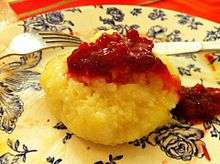
When the potato is mixed with barley flour, which is traditional in northern Sweden, it is known as palt in Lapland, Västerbotten and Norrbotten,[20] and as kams in Jämtland, Ångermanland and Medelpad.[20][22] Originally, palt was eaten all over Sweden and was made from barley or rye flour alone, but during the 19th century, when potato was added and wheat became more common and inexpensive, the northern recipes retained the original name, while kroppkaka, which had always been the name used on Öland for the flour dumpling, became the name for the variant in southern Sweden.[23]
Palt and kams is usually filled with diced, unsmoked bacon. However, sometimes fried bacon is served on the side of unfilled palt or kams, which then is known as flatpalt or flatkams, as the lack of filling makes it flatter. The most well-known palt variant is the Pitepalt from Piteå. In Dalarna, where the dish is known as klabbe, it is still made without potatoes and is never filled. Klabbe is instead served with diced bacon on the side.[24]
A variant of palt is blodpalt, where pig, beef or reindeer blood is mixed into the dough. Other palt variants are leverpalt, with minced liver added to the dough, and njurpalt, with diced kidney mixed into the bacon filling.[20] Blodpalt also existed across the country originally, and has been found in Iron Age graves in Halland.[22]
The filled kroppkaka, palt or kams ball – as well as the flatter, unfilled flatpalt, flatkams and klabbe – is dropped into boiling salted water and cooked until it floats. It is traditionally served warm with melted butter and lingonberry jam, although in some parts of southern Sweden the melted butter is replaced by half cream (a mix of milk and cream) or a warm milk sauce, and in parts of northern Sweden the butter is replaced by a warm milk sauce spiced with messmör. Leftover kroppkaka is often served halved and fried.[20]
Unfilled flour dumplings for use in soup are called klimp if the flour is wheat, but mjölpalt if the flour is barley or rye.[20]
Middle Eastern
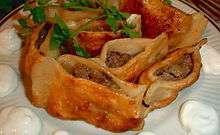
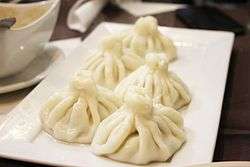
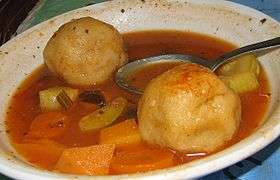
Arabic
- Asida
- Kibbeh
- Qatayef
- Shishbarak
- Gabout, (Arabic: قبوط) stuffed flour dumplings in a thick meat stew.
Caucasian
Meat-filled manti in Armenia are typically served with yogurt or sour cream, accompanied by clear soup. Mantapour is an Armenian beef soup with manta.
Boraki (Armenian: Բորակի) are a kind of Armenian fried dumplings. The main distinction of boraki is that the minced meat is pre-fried, the boraki are formed as small cylinders with an open top, the cylinders are lightly boiled in broth and then fried. Boraki are served garnished with yogurt and chopped garlic.[25]
Dushbara (Azerbaijan: Düşbərə) is an Azeri soup with tiny lamb-filled dumplings.[26]
Mataz are dumplings in Circassian and some other Caucasian cuisines, closely related to manti. They typically consist of a spiced meat mixture, usually lamb or ground beef, with greens and onions, put in a dough wrapper, either boiled or steamed. Mushrooms, potatoes, or cheese may be used in place of meat.
Israeli/Jewish
Turkish
- Manti
South Asian
Indian
|
|
|
|
|
|
Indian cuisine features several dishes which could be characterised as dumplings:
- Ada (Malayalam) is a sweet South Indian dish from Kerala. Scraped coconut mixed with sugar or jaggery is enveloped between the spread rice-dough and steamed. The sweet version of kozhakkattai is equally famous in Kerala.
- Bhajia are dumplings sometimes stuffed with vegetables and fruits.
- Fara (Hindi) is famous in North India and is very similar to dumplings. It is made of wheat flour with stuffing of lentils and similar delicacies.
- Gujhia (Hindi) is a sweet dumpling made with wheat flour, stuffed with khoya.
- Kachori (Hindi) is a round flattened ball made of fine flour filled with a stuffing of baked mixture of yellow moong dal or urad dal (crushed and washed horse beans), besan (crushed and washed gram flour), black pepper, red chili powder, salt and other spices.
- Karanji (Marathi, Oriya) or Kajjikayi (Kannada, Telugu) or kanoli are fried sweet dumplings made of wheat flour and stuffed with dry or moist coconut delicacies. They are a popular dish among Maharastrians, Oriyas and South Indians.
- Kozhakkattai (Tamil) or kadabu (Kannada), is another South Indian dish that can be sweet, salty or spicy. The outer shell is always steamed sticky rice dough. In the sweet version, a form of sweet filling made with coconuts, boiled lentils and jaggery is used, whereas in the salty version, a mixture of steamed cracked lentils, chillies and some mild spices is used.
- A dumpling popular in Western India and South India is the modak (Marathi, Oriya) or mmdhaka (Kannada) or modagam (Tamil), sugiyan (Malayalam)or kudumu (Telugu), where the filling is made of fresh coconut and jaggery or sugar while the covering is steamed rice dough. It is eaten hot with ghee.
- Nevryo (or neureo) is a sweet dumpling made dominantly in Dakshina Kannada and Udupi districts of Karnataka and Goa, just before Christmas.
- Pidi (Malayalam) is a South Indian dish from Kerala that is usually eaten with chicken curry.
- Pitha (Bihari, Oriya, Bengali, Assamese) are stuffed savouries made either by steaming or deep frying. A wide range of pithas are available in eastern and north eastern India.
- Samosa is a popular savoury snack eaten in the Indian subcontinent and Iranian plateau. It is a fried dumpling usually stuffed with mince, vegetables (mainly potatoes) and various other spices. Vegetarian variants of samosas, without the added mince stuffing, are also popular and are sold at most eateries or roadside stalls throughout the country.
- Momos are native in the Ladakh, Northeast India, and Darjeeling regions of India. The region has developed their own form of momos; from the original Tibetan version.[27]
Nepali
In Nepal, steamed dumplings known as momos (or momo-cha) are a popular snack, often eaten as a full meal as well. They are similar to the Chinese jiaozi or the Central Asian manti. This dish is native to Nepal and the concept of the dumpling was brought to Nepal by the Newar traders of Kathmandu who were trading goods with Tibet before the 1930s. Many different fillings, both meat based and vegetarian are common. Kathmandu Valley, a popular destination for momos, has with time developed its own essence for this food that differentiates it from its Tibetan counterpart.
Momos can be served fried, steamed or grilled. Momos are usually served with a dipping sauce normally consisting of tomatoes and chillies as the base ingredient, from which numerous variations can be made. Momo soup is a dish that has steamed momos immersed in a meat broth. Momos that are pan fried after steaming first are known as kothey momo, and steamed momos served in a hot sauce are called C-Momo in Nepal. Momos can also be prepared by directly deep frying without steaming first. Momos are one of the most common items on the menus of Nepali restaurants not only in Nepal but also around the world.
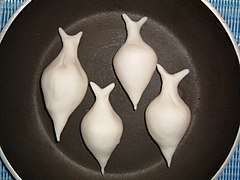
Yomari, also called yamari, is a traditional dish of the Newar community in Nepal. It is a steamed dumpling that consists of an external covering of rice flour[28] and an inner content of sweet substances such as chaku. The delicacy plays a very important role in Newaa society, and is a key part of the festival of Yomari punhi.[29] According to some, the triangular shape of the yamari is a symbolical representation of one half of the shadkona, the symbol of Saraswati and wisdom.[30]
Southeast Asian
Indonesian
Indonesian cuisine features several dishes which could be characterized as dumplings under the influence of Chinese and Portuguese.
- Jalangkote is a South Sulawesi fried pastry with an empanada shape and stuffed with vegetables, potatoes and eggs. Spicy, sweet and sour sauce will be dipped into prior to be eaten.
- Pastel is the most common empanada-shaped fried pastry to be found in Indonesia. The name was taken from Portuguese pastei. It is stuffed with ragout that is made from chicken, vegetables and eggs.
- Panada is a South Sulawesi type of fried bread similar to an empanada and stuffed with spicy tuna.
- Pangsit (wonton) is another type of dumpling that may be boiled, fried, or steamed, and often is used as complement of bakmi ayam or chicken noodle.
- Siomay is an Indonesian fish dumpling served in peanut sauce. In a different part of Indonesia such as in Surabaya, siomay can mean steamed pangsit and it will be served with bakso, meatballs soup.
See also
- Gulab jamun, a sweet, similar to a dumpling but made from milk solids
- List of dumplings
- List of foods
- Pie
References
- Gibbon, Ed (2009). "Banku & Kenkey". The Congo Cookbook. Archived from the original on 13 January 2018. Retrieved 22 July 2011.
- "CUSTOMS". Tigrai Online. Retrieved 3 January 2013.
- GT in SA (16 August 2005). "Souskluitjies (Dumplings In Cinnamon Syrup)". FOOD. Food.com. Archived from the original on 21 January 2012. Retrieved 22 July 2011.
- evelynathens (17 June 2006). "Souskluitjies (South African Dumplings In Custard Sauce)". FOOD. Food.com.
- Swanepoel, Sharon. "South African Recipes". God's Glory Ministries International.
- "101 Best Comfort Food Classics: Classic Chicken and Dumplings". Southern Living. Time Inc. Lifestyle Group. Retrieved 12 September 2017.
- https://omnivorescookbook.com/recipes/how-to-make-chinese-dumplings
- CCTV纪录 (26 February 2018), 《舌尖上的中国》第三季 第七集 生 | CCTV纪录, retrieved 3 March 2019
- Zhao, Rongguang; Wang, Gangliu; Wang, Aimee Yiran (January 2015). A History of Food Culture in China. SCPG PUBLISHING CORPORATION. doi:10.1142/z008. ISBN 9781938368165.
- Griffin, Ana Carolina (3 September 2019). "Gastronomía callaoense sobrevive puertas adentro". El Estímulo (in Spanish). Retrieved 19 September 2019.
- "Norfolk Dumplings Recipe". The Green Chronicle. Archived from the original on 15 September 2008. Retrieved 20 July 2008.
- "Cotswold Dumpling Recipe". The Green Chronicle. Archived from the original on 24 September 2008. Retrieved 20 July 2008.
- Cropley, May. "Clootie Dumpling Recipe". Scotlands-Enchanting-Kingdom.com. Archived from the original on 13 September 2008. Retrieved 20 July 2008.
- Пельменів не буде — будуть равіолі? Нові стандарти на заморожені напівфабрикати відклали до весни [Dumplings will or will not be ravioli? New standards for frozen semi-finished products postponed to Spring]. pogliad.ua (in Ukrainian). 19 December 2008.
- Dal Dictionary Online derives the etymology of pel'men' from pel'=ear and nan'=bread in Komi and Mansi (Vogul) languages. This may be why pelmeni are called uszka ("ears") in Poland.
- Also in Max Vasmer's etymological dictionary of the Russian language. See: пельмень - Этимологический онлайн-словарь русского языка Макса Фасмера (in Russian)
- Jacob, Jeanne; Ashkenazi, Michael (2007). The World Cookbook for Students, Volume 1. Greenwood Press. ISBN 978-1573567640.
- Nasmyth, Peter (2006). Georgia: in the Mountains of Poetry. Taylor & Francis. ISBN 978-0203966723.
- Petrosian, Irina; Underwood, David (2006). Armenian Food: Fact, Fiction & Folklore. Bloomington, Indiana, USA: Yerkir Publishing. ISBN 978-1-4116-9865-9.
- "Om kroppkakor, palt & kams" [About kroppkakas, palts and kams]. Kunskapskokboken (Knowledge Cookbook) (in Swedish). Krister Hanner. Retrieved 13 April 2015.
- "Kroppkakor från Blekinge" [Kroppkakas from Blekinge]. In the Kitchen (in Swedish). 19 February 2013. Retrieved 13 April 2015.
- "Palt/Kams". Smaka Sverige (in Swedish). Retrieved 13 April 2015.
- "Kroppkakor". Smaka Sverige (in Swedish). Retrieved 13 April 2015.
- "Klabbe med fläsk och messmörsås" [Dumplings with pork and mess butter (Messmör) sauce]. Matklubben (in Swedish). Retrieved 13 April 2015.
- "Бораки" [Boraki]. Кулинарные Рецепты (Culinary Recipes) (in Russian). Retrieved 12 September 2017.
- "Dumplings / Dushbara". Azerbaijan International. 8 (3). Autumn 2000. Retrieved 5 April 2009.
- Lynelle Seow (15 January 2017). CultureShock! India. Marshall Cavendish International Asia Pte Ltd. pp. 202–. ISBN 978-981-4771-98-6.
- Goldstein, D.; Mintz, S.; Krondl, M.; Mason, L. (2015). The Oxford Companion to Sugar and Sweets. Oxford Companions. Oxford University Press. p. 634. ISBN 978-0-19-931339-6. Retrieved 5 November 2016.
- Roufs, T.G.; Roufs, K.S. (2014). Sweet Treats around the World: An Encyclopedia of Food and Culture. ABC-CLIO. p. 237. ISBN 978-1-61069-221-2. Retrieved 5 November 2016.
- Basu Pasa (बासुपासा). Kantipur (कान्तिपुर) (in Nepali). Kathmandu.
External links

